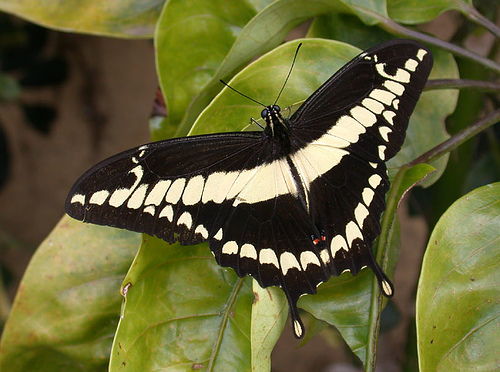
Heraclides cresphontes, or Papilio cresphontes (Heraclides cresphontes, or Papilio cresphontes)
Phylum — arthropoda
Class — insecta
Order — lepidoptera
Family — papilionidae
Genus – papilio
Appearance
One of the Heraclides cresphontes most notable features is its size. Females have an average wingspan of 5.5 in (14 cm), and up to 6.9 in (18 cm), while males' average is 5.8 in (15 cm), and up to 7.4 in (19 cm).
The wings are black with a horizontal yellow line across the forewings, and a diagonal yellow line across the hindwing. The underside of the wings is yellow with accents of black. A small patch of red on the ventral wing (within the small blue band) allows for distinction from the similar-looking Schaus' swallowtail.
Habitat
Heraclides cresphontes is common across the United States, reaching as far north as southern New England and southern Canada. South of the United States, it is found in parts of Mexico and also found in Jamaica and Cuba.
Behavior
Larvae are mostly nocturnal, feeding at night. Butterfly caterpillars have two effective mechanisms for protecting against birds. If the caterpillar is disturbed, it exposes osmeterium, which emits pheromones with a pungent smell. In addition, resembling bird droppings, the color of the caterpillar makes it invisible for birds.
Because of the butterfly's notably large wings, Heraclides cresphontes are very strong fliers and are able to glide long distances with very few wing beats.
Diet
As well as eating valuable citrus crops, larvae eat a wide variety of plants in the family Rutaceae (citrus plants), including different types of prickly ash. They also consume some exotic Rutaceae species that have been introduced to North America, such as gas plant and sapote.
Nectar plants for adults include Lantana, Azaleas, Bougainvilla, Saponaria officinalis, Hesperis matronalis, Solidago, Lonicera japonica, and Asclepias incarnata. Along with flower nectar, adults can also consume liquid from animal waste.
Lifecycle
Females lay eggs on the tops of the leaves of one of their preferred host plants. This is because the first larval instars are unable to move from plant to plant, so the mother must select an appropriate plant to support them. One egg is lain at a time, as opposed to in clutches. The small egg (1–1.5 mm) is brownish colored, but appears more orange due to a special orange colored secretion.
Once emerged from the eggs, there are five larval instars, wherein the larva grow to about 2 inches before pupating. The caterpillars have remarkable camouflage patterns.
Larvae must find a vertical plant, or sometimes a man-made object, to form their chrysalis on, and often they choose the host plant they already occupy. They attach themselves to their substrate of choice and molt to reveal a brown, mottled chrysalis (resembling a bit of dead twig) in which they remain for approximately 10–12 days.
Adult butterflies live from 1 to 3 weeks.
 Russian
Russian
 English
English























